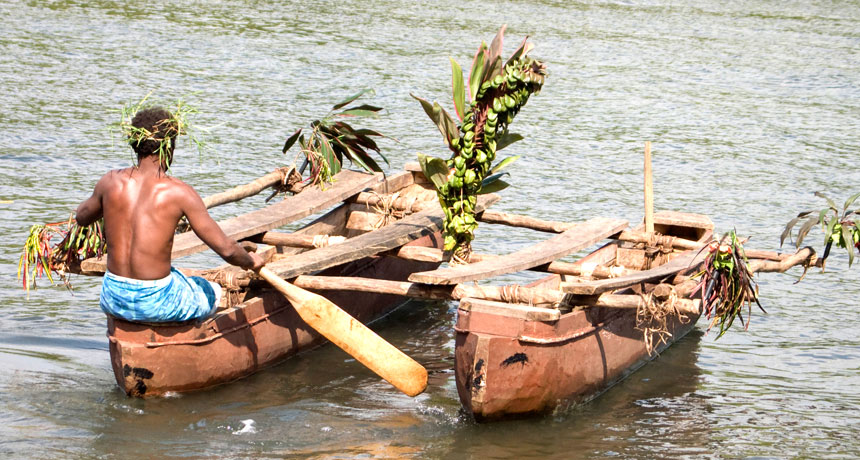Pacific islanders got a double dose of Stone Age DNA
Melanesians are the only people known to have DNA from two ancient human ‘cousins’

Modern-day Melanesians, like this man, inherited DNA from both Neandertals and Denisovans.
SpotX/iStockPhoto
By Bruce Bower
Unlike people in the rest of world, some modern-day Pacific Islanders have inherited genes from two different groups of Stone Age relatives. That’s the conclusion of new research. And the ancient DNA they carry still affects their health and well-being — in a good way.
Melanesians live in a group of islands northeast of Papua New Guinea. Their ancestors mated with Neandertals, the new data show. They also mated with mysterious Neandertal relatives, known as Denisovans.
Population geneticist Benjamin Vernot and his colleagues made the discovery. At the time, Vernot was working at the University of Washington in Seattle. His group published its findings online March 17 in Science.
The new study looked at DNA that both parents pass to their children. (Other DNA is typically passed down only by moms.) As earlier studies had shown, non-African people have a little bit of Neandertal DNA.
This includes the Melanesians. On average, they inherited 1.5 to 4 percent of their DNA from Neandertals. But Melanesians have DNA from Denisovans too. This makes up 1.9 to 3.4 percent of their DNA, the new study finds. (Today’s Africans have little to no Neandertal or Denisovan DNA.)
In modern Melanesians, the bits of Neandertal and Denisovan DNA include genes involved in metabolism and immunity. That means mating with other hominids — other species of human ancestors — may have helped ancient humans thrive, the scientists say.
Pontus Skoglund, who studies ancient genes at Harvard University, didn’t work on the new study. But that study pieces together the evolution of Melanesian DNA “in impressive detail,” he says.
Findings from the DNA
The new study sampled DNA from 35 Melanesians. Those people came from 11 places throughout a chain of islands known as the Bismarck Archipelago. They scientists focused on DNA from 27 unrelated people in this group. The researchers also looked for signatures of Neandertal and Denisovan DNA in nearly 1,500 modern-day people from elsewhere around the world.
The scientists compared these modern DNA samples to those left behind by ancient Denisovans and Neandertals. The Denisovan DNA came from fossils found in a Siberian cave. Other researchers had taken the Neandertal DNA from a 50,000-year-old woman’s toe bone.
In Melanesians, the Neandertal and Denisovan DNA included some metabolism genes. One of those genes affects a hormone that raises blood sugar levels. Another affects the breakdown of fats. Still other bits of ancient DNA in Melanesians affect the immune system.
An earlier study found that genes passed down from Neandertals, even if they were once useful, might raise the risk of certain diseases today. Vernot’s group does not know whether that’s true for the ancient DNA seen in the Melanesians.
There’s no sign of Neandertal or Denisovan DNA in the genes of Melanesians that play a role in brain development. The evolution of brain genes, therefore, appears purely human, the scientists say.
Scientists still don’t know much about how Denisovans evolved. Earlier DNA studies suggested they once lived in Southeast Asia. Skoglund thinks that’s where the ancestors of Melanesians would have mated with Denisovans.
There was likely just one period of mating between humans and Denisovans, Vernot and his colleagues suspect. Mating between humans and Neandertals happened at least three times, they note. They can estimate this by comparing Denisovan and Neandertal DNA sequences among people in different parts of the world.
Power Words
(for more about Power Words, click here)
archipelago A group of islands, many times forming in an arc across a broad expanse of the oceans. The Hawaiian islands, the Aleutian islands and the more than 300 islands in the Republic of Fiji are good examples.
blood sugar The body circulates glucose, a type of simple sugar, in blood to tissues of the body where it is used as a fuel. The body extracts this simple sugar from breakdown of sugars and starches. However, some diseases, most notably diabetes, can allow an unhealthy concentration of this sugar to build up in blood.
Denisovans An ancient humanlike population whose existence is known only because of a few fossils discovered in a cave in Siberia.
evolution A process by which species undergo changes over time, usually through genetic variation and natural selection. These changes usually result in a new type of organism better suited for its environment than the earlier type. The newer type is not necessarily more “advanced,” just better adapted to the conditions in which it developed.
gene (adj. genetic) A segment of DNA that codes, or holds instructions, for producing a protein. Offspring inherit genes from their parents. Genes influence how an organism looks and behaves.
hominid A primate of an animal family that includes humans and their ancient, fossil relatives.
hormone (in zoology and medicine) A chemical produced in a gland and then carried in the bloodstream to another part of the body. Hormones control many important body activities, such as growth. Hormones act by triggering or regulating chemical reactions in the body.
immune system The collection of cells and their responses that help the body fight off infections and deal with foreign substances that may provoke allergies.
immunity The ability of an organism to resist a particular infection or poison by producing and releasing special protective cells.
metabolism The set of life-sustaining chemical reactions that take place inside cells and bigger structures, such as organs. These reactions enable organisms to grow, reproduce, move and otherwise respond to their environments.
Neandertal A species (Homo neanderthalensis) that lived in Europe and parts of Asia from about 200,000 years ago to roughly 28,000 years ago.
Stone Age A prehistoric period, lasting millions of years and ending tens of thousands of years ago, when weapons and tools were made of stone or of materials such as bone, wood, or horn.







